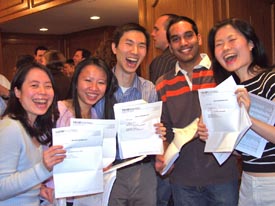Excitement Rules at Match Day
 Flying confetti accompanied the opening of “official” envelopes at this year’s Match Day. Gathering at a hotel near campus on March16, fourth-year students at the Feinberg School of Medicine accompanied by friends and family members awaited residency training matches with excitement mixed with a bit of trepidation. They joined 15,000 students around the country who were participating in the National Resident Matching Program (NRMP), a process that uses a computer algorithm to align the preferences of residency programs at teaching hospitals with the hopes and dreams of individuals embarking on the next stage of their medical training.
Flying confetti accompanied the opening of “official” envelopes at this year’s Match Day. Gathering at a hotel near campus on March16, fourth-year students at the Feinberg School of Medicine accompanied by friends and family members awaited residency training matches with excitement mixed with a bit of trepidation. They joined 15,000 students around the country who were participating in the National Resident Matching Program (NRMP), a process that uses a computer algorithm to align the preferences of residency programs at teaching hospitals with the hopes and dreams of individuals embarking on the next stage of their medical training.
This year 165 Feinberg students found their “matches” through the NRMP, with 24 of them receiving their results before the “official” Match Day through early programs or military matches. The most popular specialty choices among Northwestern students were internal medicine, pediatrics, emergency medicine, and general surgery.
Nationally, many of the upcoming graduates of U.S. medical schools chose to pursue careers in highly competitive medical specialties such as surgery, dermatology, and anesthesiology, according to the NRMP. The competition for several popular residencies was fierce among the 26,715 applicants participating in this year’s Match. Ninety-eight percent of internal medicine positions were filled, with 56 percent of them by U.S. medical school seniors—the highest number in three years.
 In 2006 otolaryngology programs joined the Match for the first time. Ninety-eight percent of positions in that specialty area found matches; soon-to-be U.S. graduates filled 92 percent of those spots. All but one of the 1,047 general surgery positions were filled through the NMRP. More than 83 percent of those openings were taken by U.S. graduating medical students.
In 2006 otolaryngology programs joined the Match for the first time. Ninety-eight percent of positions in that specialty area found matches; soon-to-be U.S. graduates filled 92 percent of those spots. All but one of the 1,047 general surgery positions were filled through the NMRP. More than 83 percent of those openings were taken by U.S. graduating medical students.
Fourth-year students took into account their lifestyle preferences when selecting residencies, according to the NMRP. Programs that offer reasonable work hours and demands attracted individuals looking for work-life balance. All first-year residency positions in dermatology were filled through this year’s Match, with U.S. medical school seniors filling 93 percent of those positions. In anesthesiology, 97 percent of the available positions found matches. More than 80 percent of those were filled by U.S. seniors—the highest number in several years.
Of course, the availability of strong clinical and/or research programs that met individual interests had much to do with selection criteria. Graduating Northwestern MD/PhD student, Jose Otero was thrilled to receive his first choice: a pathology residency at the University of California at San Francisco. The program’s research opportunities in stem cell biology drew him to the program. A native of Louisiana, Otero and his wife, Catherine, a Northwestern PhD degree candidate in neuroscience, can’t wait to move to the City by the Bay.
“I am very happy,” said a relieved Otero. “Aside from unpacking, the first thing I am going to do when I get to San Francisco is go out and get some sushi.”






